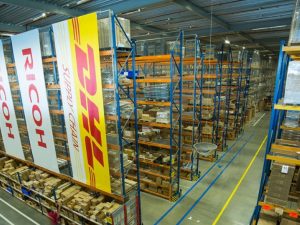The latest preliminary figures from WorldACD Market Data indicate that air cargo tonnages recovered at the end of January and the beginning of February, as expected after the early Lunar New Year this year, but the increase was significantly stronger than in the equivalent period last year. Figures for week 5 (30 January to 5 February) show an increase of +11 per cent in worldwide tonnages compared with the previous week, following a large decrease the week before of -13 per cent, mainly driven by the Lunar New Year that started on 22 January. In the same period last year, tonnages increased by +3 per cent. After falling by around -8 per cent in week 4, the global average rate level recovered slightly (+1 per cent) compared with the previous week, similar to the trend observed last year, but prices remain well below their level prior to Lunar New Year. Comparing weeks 4 and 5 with the preceding two weeks (2Wo2W), tonnages are down significantly (-8 per cent) below their combined total in weeks 2 and 3, with average worldwide rates also down by -8 per cent, despite a -4 per cent decrease in capacity – based on the more than 400,000 weekly transactions covered by WorldACD’s data. On a regional level, the effect of the Lunar New Year on air cargo tonnages was most notable on flows outbound from Asia Pacific to Europe (-41 per cent), North America (-40 per cent) and the Middle East & South Asia (-38 per cent), respectively, but also on intra-Asia Pacific flows (-23 per cent). Strong increases were recorded from Central & South America to North America (+37 per cent), from Africa to …
Read More »Air freight rates decline but above pre-COVID levels
Airfreight rates continued their downward spiral in January but are still above pre-Covid levels, according to the latest statistics from the Baltic Exchange Airfreight Index (BAI). It shows that average rates – both contract and spot – paid by forwarders on services from Hong Kong to North America in January declined to $6.14 per kg compared with $6.50 per kg in December and $10.90 per kg a year ago. However, rates on the trade are still 67.8% above the $3.66 per kg registered in January 2019 (pre-Covid). It was a similar story in services from Hong Kong to Europe where prices fell to $4.96 per kg from $5.52 per kg in December and $6.61 per kg a year ago. On this trade, rates stood at $2.83 per kg in January 2019. Rates are supported by higher fuel prices, the lack of belly hold capacity on certain trades and ongoing expensive charter/BSA operations signed at the height of the pandemic. On capacity, figures from Boeing presented at the recent World Cargo Summit show that overall capacity in November was only around 3% behind 2019 levels, but belly capacity was 23% down, with the difference made up by a 16% increase in dedicated freighters.
Read More »BLR records highest cargo tonnage in FY 2022
The Kempegowda International Airport, Bengaluru (BLR Airport) recorded its highest-ever cargo tonnage in Financial Year (FY) 2022, despite challenging circumstances due to multiple Covid waves. BLR Airport processed an all-time high tonnage for a fiscal year since Airport Opening Day (AOD) of 411,513 Metric Tonnes (MT) of cargo, recording a growth of 26% as against 326,643MT in FY 2021. International cargo recorded a 31.1% growth, 271,988MT processed, as compared to 207,518 MT in FY 2021. Domestic cargo grew at 17%, with 139,525MT versus 119,125MT in FY 2021. Perishable cargo has been one of the major growth drivers for BLR Airport. It is the No.1 airport in the country for handling perishables — estimated to account for 31% of India’s total perishable shipments. BLR Airport processed 39,518 MT of cargo in October 2021 — the highest ever for a month since AOD. International cargo processed (both imports and exports) was also the highest ever in October 2021, accounting for 25,695 MT. The Airport achieved a significant record by gaining 13% of India’s air cargo market share and 45% of South India’s air cargo market share. With this achievement, BLR Airport has become the only major airport in the country to show growth over pre-pandemic levels.
Read More »Multimodal connectivity will improve growth
JB Singh, Director MOVIN said, “The budget is in line with the government’s long-term goal of having a successful and integrated logistics industry. This industry will be more competitive with this budget. The effective multimodal connectivity initiative will act as a catalyst for the overall sector’s improvement. Logistics is established as a major economic pillar by the government’s emphasis on the railway infrastructure and crucial transport projects for first and last-mile delivery of the specified sectors. Additionally, the emphasis on upskilling people and the introduction of the digital infrastructure will lead to more young employment in this sector, establishing a complete ecosystem. This would help in lowering the cost of logistics while also facilitating trade and bringing India into compliance with international standards.”
Read More »Budget will resolve supply chain inefficiencies
Raaja Kanwar, Chairman and Managing Director, Apollo Supply Chain and Apollo International Limited share his views on the Union Budget 2023, he said, “The Union Budget 2023 lays out a credible roadmap towards the development of transport infrastructure and last-mile connectivity. We congratulate the budget for making Green Growth one of the top 7 priorities; focusing on ease of doing business. As, Apollo Supply chain, we look forward to resolving the inefficiencies in the country’s supply chain.”
Read More »“Govt should focus on NLP, tech & sustainability’
Sharing his expectations from the upcoming budget, Malay Shankar, CEO, ProConnect Supply Chain Solutions Ltd says, “In the post-pandemic reality, the logistics sector has been flourishing, contributing immensely to the national economic growth. Since the Indian government focuses on accelerating economic development, strategic announcements and changes for Supply Chain and Logistics Industry will have a wide-spreading impact. Here are some of the sector’s expectations from the government to fast-track the economy’s productivity. Firstly, the New Labour Code directly impacts the blue-collar workers who are the backbone of the logistics and supply chain industry. Bringing in more straightforward means of enforcing it, while ensuring social security and economic benefit to the blue-collar workers will fetch long-lasting results. Getting rid of ambiguity and having simpler ways of implementation will help industrial workers. Coupled with the supportive Digital India policies, the government can thrust on closing the digital gap that persists in the industry. With lucrative sops for players bridging this gap by skill training to their workforce, the government can boost leaders in the space to catalyse the digital evolution of the sector.” He adds, “On the other hand, we really hope the government will strengthen the foundation of National Logistics Policy (NLP) and implement it to ease bottlenecks and reduce costs. Along with that, an improved road network will decongest roads, facilitate seamless transportation of goods and get better land value for the warehousing hubs. The sector is keenly looking at adopting greener practices. Offering tax benefits and incentives to the warehousing industry for deploying solar-enabled solutions and other green practices will go a long way in reducing the carbon footprint of the sector as a whole.”
Read More »“Focus on increasing tech adoption in cold chain sector”
Industry expert, Swarup Bose, Founder & CEO of Celcius Logistics shares his expectations for the upcoming budget. He says, ” The Indian cold supply chain industry has rapidly grown, especially post-COVID. In 2021, the Indian cold chain logistics market was valued at $24.62 Billion, and it is expected to reach $53.07 Billion by 2027, growing at a CAGR of 13.66% from 2021 to 2027. However, currently, the cold supply chain sector is highly fragmented and marred with severe challenges, leading to the wastage of 40% of the over 400 million MT of perishable food! And according to the Associated Chamber of Commerce, our post-harvest losses amount to a whopping $14bn.” He adds, “While there has been a strong focus by the government on Logistics as a sector, a renewed and closer look at Cold Supply Chain would benefit in cutting losses and improving the hunger index while also empowering agriculture, food & dairy and process food sectors, along with pharma and healthcare. Listed here are a few points that, if considered in the Union Budget 2023-24, would go a long way in creating a robust, seamless and effective cold supply chain network: 1. Capital support/ FDI for technology adoption: The huge capital investment required for digital adoption in the cold supply chain sector, is a massive challenge. With provisions for FDI and capital support, it will be easier to bring in the best in tech innovations that can be applied across the cold supply chain and truly empower all stakeholders to embrace smart tech. 2. Tax holidays/ subsidies for critical Cold Storage: Temperature-controlled warehousing is an investment intensive yet one of the most crucial aspects of the cold supply chain …
Read More »“Develop multimodal infra, capacity & connectivity”
Ketan Kulkarni, Chief Commercial Officer, Blue Dart shares his expectations for the logistics sector. He says, “As we emerge from the polycrisis , I believe that for the growth of the logistics sector, technology adoption will be key to achieving operational efficiency and a tool to reach a wider customer base, alongside providing best-in-class solutions & services. Given that the overall consumption in the country will more than double from $2 trillion in 2022 to $4.9 trillion by the end of the decade, logistics will be a key enabler to facilitate trade & consumption. The sector will need to address the complexities of the new normal by becoming more data-driven, agile and embedded intelligent systems to improve efficiency and also enhance the customer experience. The double engines of the PM Gati Shakti plan and the National Logistics Policy (NLP) will be highly effective in this regard. This budget should fund multiple interventions across the logistics ecosystem under the NLP so that its impact is visible over the next 12–18 months. This would lead to the development of world-class infrastructure especially on the multimodal transport front, while also addressing the need to digitalise a well-integrated assets platform, and regulate & build capacities needed for the sector making it future ready for the nation to grasp all the opportunities that come its way.”
Read More »DHL opens New e-com Fulfilment Center in Luhari
DHL Supply Chain recently opened an E-commerce Fulfilment Centre at Luhari, India, for Adidas, one of the global market leaders in the sporting goods industry. Spread across 200,000 sq. ft., the 24×7 operation has a storage capacity of over three million units and meets stringent global standards of health and safety. This site is in addition to the Adidas Central Distribution Centre, one of India’s largest centralized sporting goods facilities, with a footprint of 300,000 sq. ft. in Luhari. Operated by DHL Supply Chain, this site primarily caters to retail and institutional customers. The new facility consolidates two of Adidas sites which will effectively cater to the growing e-commerce sector with greater operating efficiencies. “Growing the Direct to Consumer business is a strategic priority for us in our Own the Game strategy. In India, Adidas launched its digital flagship store and app in 2021. We further invested in this new facility in 2022 to continue to capture the potential of the e-commerce business in India as well as enhance the consumer experience for consumers shopping on our website and app,” said Neelendra Singh, Managing Director, Adidas India. The e-commerce market in India is expected to be USD 74.8 billion by the end of 2022 and is projected to grow at approximately 21per cent to USD 350 billion by 2030. This shift has been facilitated by the movement of both buyers and sellers to online channels. “We are delighted to continue our close seven-year partnership with adidas and offer our expertise to set up world-class infrastructure to meet the growing needs of our customers,” said Vikas Anand, Managing Director, DHL Supply Chain, India. “This new modern facility has been built to …
Read More »Reduce fuel, electricity, steel, cement, labour costs
Sunil Nair, CEO, Snowman Logistics shares his expectations from the upcoming budget 2023-2024 and says “In 2023, the logistics industry will go through a restructuring of the distribution network that will drive a lot of changes, both for big and small organizations, majorly driven by the National Logistics Policy. The rising input costs of fuel, electricity, steel, cement, and labour are major challenges for the sector, making operations costlier. This needs to be fixed otherwise cold chain companies will be impacted the most. The year is expected to bring in technology upgrades to make things efficient in the long term.”
Read More » Cargo Breaking News
Cargo Breaking News








